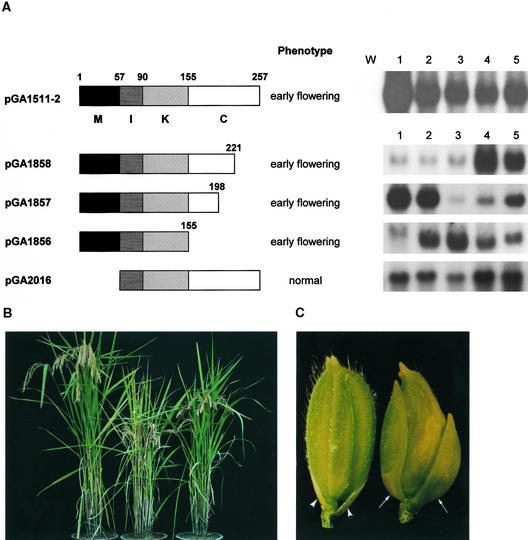Figure 1.
Construction of Truncated OsMADS1 and Phenotype of Transgenic Plants.
(A) Schematic representations of truncated OsMADS1 proteins, phenotype, and RNA gel blot analyses of the transgenic plants. Shown at left is the OsMADS1 protein represented by four regions: M, MADS domain; I, I region; K, K domain; C, C-terminal region. The numbers indicate the boundaries of the regions and the positions of the truncations. In the center is the phenotype of the T2 transgenic rice plants that express the construct given at left. Shown at right are RNA gel blot data from the independent transgenic plants, which were derived from transformation of the constructs shown at left. Equal amounts of total RNA loading were examined by using ethidium bromide staining of 25S and 18S rRNAs (data not shown). In pGA1511-2 transgenic lines, line 1 flowered ∼10 days earlier than wild-type or control plants carrying the binary vector pGA1671; the other lines flowered ∼5 days earlier than controls. In pGA1858, pGA1857, and pGA1856 transgenic lines, lines 1858-4, 1858-5, 1857-1, 1857-2, 1857-5, 1856-2, 1856-3, 1856-4, and 1856-5 flowered ∼5 days earlier than controls, and other lines did not show early flowering. Five micrograms of total RNA from prepared leaves was loaded in all other lanes. The C-terminal region of OsMADS1 was used as a gene-specific probe (Chung et al., 1994), except that RNAs from pGA1856 lines were hybridized with the K region of OsMADS1. W, wild-type plants; numbers, independent transgenic lines.
(B) Phenotypes of transgenic plants expressing full-length OsMADS1 or the C-terminal truncated form. Shown at left is a control plant transformed with the binary vector pGA1671; at center is the transgenic plant with pGA1511-2 (line 1511-2-1); at right is the transgenic plant with pGA1856 (line 1856-2).
(C) Spikelets of the wild type (left) and transgenic line 1511-2-1 (right). Normal glumes are short and inconspicuous (arrowheads), whereas the transgenic spikelet shows overgrowth of glumes (arrows) that resemble paleae and lemmas. This phenotype was observed in most transgenic plants expressing the full-length or the C-terminal–truncated OsMADS1.

